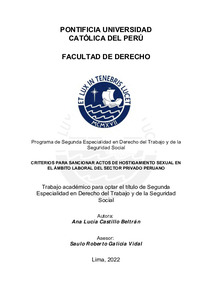| dc.contributor.advisor | Galicia Vidal, Saulo Roberto | |
| dc.contributor.author | Castillo Beltrán, Ana Lucía | |
| dc.date.accessioned | 2024-04-01T15:15:29Z | |
| dc.date.available | 2024-04-01T15:15:29Z | |
| dc.date.created | 2022 | |
| dc.date.issued | 2024-04-01 | |
| dc.identifier.uri | http://hdl.handle.net/20.500.12404/27452 | |
| dc.description.abstract | El presente trabajo de investigación ha buscado responder la siguiente pregunta:
¿Cuáles son los criterios para sancionar actos de hostigamiento sexual en el
ámbito laboral del sector privado?
Por ello, el objetivo principal del presente trabajo fue determinar dichos criterios,
a fin de que, así, se pueda tener un panorama más claro sobre qué tipo de
sanción aplicar según el tipo de acto cometido y su gravedad, lo cual no hace la
normativa sobre la materia. En esa línea, se ha analizado el concepto de
hostigamiento sexual, los bienes jurídicos que la normativa sobre la materia
busca proteger, la particularidad del poder disciplinario en esta materia, los
principios jurídicos de nuestro ordenamiento para aplicar sanciones en materia
laboral, así como la utilidad del modelo de justicia restaurativa dentro del
procedimiento de investigación y sanción.
Así, dentro de las principales conclusiones a las que hemos llegado, se
encuentra la referida a la necesidad de una modificación normativa del D.S. N°
014-2019-MIMP, Reglamento de la ley de prevención y sanción del
hostigamiento sexual, para que se establezca expresamente los criterios de
tipicidad, proporcionalidad y razonabilidad para aplicar una sanción; fomentar un
espacio basado en el modelo de justicia restaurativa para los actos calificados
como leves; y también se recomienda adecuar la Guía emitida por el Ministerio
de Trabajo y Promoción del Empleo (MTPE), en la que se tendría que incluir una
clasificación de actos de hostigamiento sexual, según su nivel de gravedad y
sanción aplicar. | es_ES |
| dc.description.abstract | This research work has sought to answer the following question: What are the
criteria for sanctioning acts of sexual harassment in the private sector workplace?
Therefore, the main objective of this paper was to determine such criteria, in order
to have a clearer picture of what type of sanction to apply depending on the type
of act committed and its severity, which is not done in the regulations on the
subject. In this line, we have analyzed the concept of sexual harassment, the
legal assets that the regulations on the matter seek to protect, the particularity of
the disciplinary power in this matter, the legal principles of our legal system to
apply sanctions in labor matters, as well as the usefulness of the restorative
justice model within the investigation and sanction procedure.
Thus, among the main conclusions we have reached, there is the one referred to
the need for a regulatory amendment of D.S. No. 014-2019-MIMP, Regulation of
the Law on Prevention and Punishment of Sexual Harassment, to expressly
establish the criteria of typicality, proportionality and reasonableness to apply a
sanction; to promote a space based on the restorative justice model for acts
classified as minor; and it is also recommended to adapt the Guide issued by the
Ministry of Labor and Employment Promotion (MTPE), which should include a
classification of acts of sexual harassment, according to their level of severity and
sanction to be applied. | es_ES |
| dc.description.uri | Trabajo académico | es_ES |
| dc.language.iso | spa | es_ES |
| dc.publisher | Pontificia Universidad Católica del Perú | es_ES |
| dc.rights | info:eu-repo/semantics/closedAccess | es_ES |
| dc.subject | Acoso sexual | es_ES |
| dc.subject | Mujeres--Trabajo | es_ES |
| dc.subject | Derecho laboral--Perú | es_ES |
| dc.title | Criterios para sancionar actos de hostigamiento sexual en el ámbito laboral del sector privado peruano | es_ES |
| dc.type | info:eu-repo/semantics/bachelorThesis | es_ES |
| thesis.degree.name | Segunda Especialidad en Derecho del Trabajo y de la Seguridad Social | es_ES |
| thesis.degree.level | Título Profesional | es_ES |
| thesis.degree.grantor | Pontificia Universidad Católica del Perú. Facultad de Derecho | es_ES |
| thesis.degree.discipline | Derecho del Trabajo y de la Seguridad Social | es_ES |
| renati.advisor.dni | 46591339 | |
| renati.advisor.orcid | https://orcid.org/0000-0002-4405-1876 | es_ES |
| renati.author.dni | 71497902 | |
| renati.discipline | 422059 | es_ES |
| renati.level | https://purl.org/pe-repo/renati/level#tituloSegundaEspecialidad | es_ES |
| renati.type | https://purl.org/pe-repo/renati/type#trabajoAcademico | es_ES |
| dc.publisher.country | PE | es_ES |
| dc.subject.ocde | https://purl.org/pe-repo/ocde/ford#5.05.01 | es_ES |






